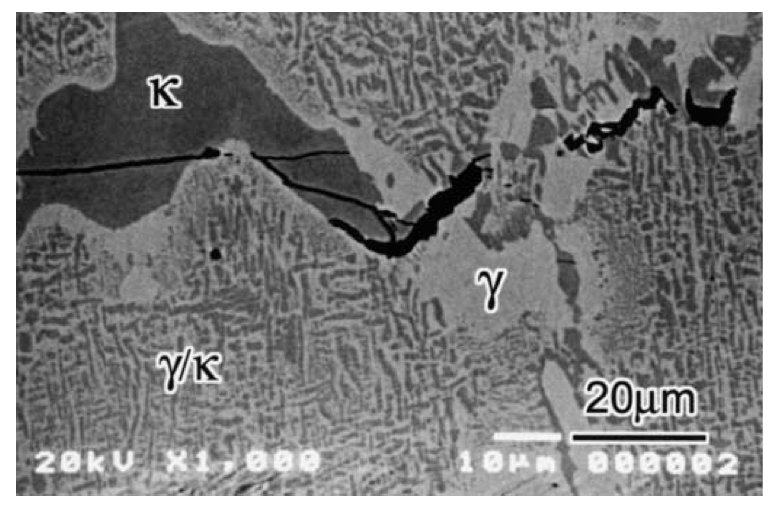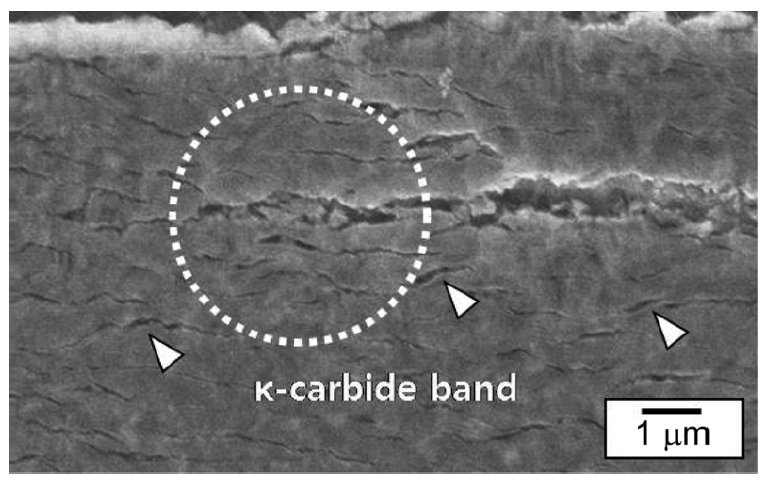
Alphabetical Index
Chemical Composition of Steels
Keyword Search
Steel Names
Alloyed Steels
Carbon Steels
Cast Irons
Chromium Steels
Cold Work Tool Steels
Creep Resistant Steels
Hot Work Tool Steels
Molybdenum Steels
PM steels
Stainless Steels
Structural Steels
Tool Steels
Vanadium Steels
White Cast Irons
M2C Carbides
M3C Carbides
M7C3 Carbides
M23C6 Carbides
MC Carbides
Light Microscopy
EDS/WDS Microanalysis
Scanning Electron Microscopy
Transmission Electron Microscopy
X-Ray Diffraction
Help
Contact Us
Home
Kappa carbides in Fe-(4 6)Mn-(6 8)Al-0.3C steel

Figure 1: A back-scattered electron image of the tensile specimen in
the vicinity of fracture surface of the Fe-29Mn-9Al-2.6C (in mass%) alloy
(Kimura et al., 2004). Scale bar: 20 µm.

Figure 2: Scanning Electron Microscope (SEM) micrographs of the crosssectional
area beneath the tensile fracture surface of the Fe-(4 6)Mn-(6 8)Al-
0.1C (mass%) alloy. Crack was initiated in kappa-carbide and rapidly propagated
into ferrite (Han et al., 2010). Scale bar: 5 µm.

Figure 3: SEM micrographs of the cross-sectional area beneath the tensile
fracture surface of the Fe-(4 6)Mn-(6 8)Al-0.3C (mass%) alloy. Crack in
the kappa-carbide band is short and discrete (Han et al., 2010). Scale bar: 1 µm.
Carbide name: Kappa carbide
Record No.: 1232
Carbide formula: (Fe,Mn)3AlC
Carbide type: No data
Carbide composition in weight %: No data
Image type: SEM
Steel name: Fe-(4 6)Mn-(6 8)Al-0.3C
Mat.No. (Wr.Nr.) designation: No data
DIN designation: No data
AISI/SAE/ASTM designation: No data
Other designation: No data
Steel group: High manganese and high aluminum steels
Steel composition in weight %: Fe-29Mn-9Al-2.6C
Heat treatment/condition: No data
Note: (Fe,Mn)3AlC kappa-carbides are important substance in high strength
light-weight steels. Kappa-carbide is known to initiate crack and propagate
the crack or, otherwise, pin the slips and make uniform shear
bands. These opposite properties was decided by environment of the
system. Therefore phase diagram of Fe-Mn-Al-C quaternary system
and kappa-carbide is vital for this kind of steels. However, there is no
solid thermodynamic value and stability of kappa-carbide. To work towards
this goal, the all-electron full potential linearized augmented
plane-wave method(FLAPW) was used within the generalized gradient
approximation. The formation enthalpies of various kappa-carbides are
calculated. All of kappa-carbides have negative formation enthalpy. The
lowest kappa-carbide formation was Fe2MnAlC which is 9.5 kJ atom-mol.1
lower than the highest formation Fe3AlC. When the carbon position
was changed to another octahedral position in Fe2MnAlC, the formation
energy becomes positive but magnetic moment was increased. In
this research, first-principles calculation result was reassessed using
Monte-Carlo cell gas model. The result of Monte-Carlo simulation
showed smaller entropy value than configurational entropy caused by implementation problem. However, general temperature dependence
of free energy, entropy, specific heat and internal energy is well predicted
by simulation. In the future work, we hope to incorporate
the calculated energies in to phase diagram calculation methods and
modify cell gas model to improve implementation problem.
In general, carbide is harder than pure iron and strengthens steels. However,
it can also be brittle, therefore, it initiates cracks or helps the propagation
of cracks. Also, the phase which is surrounding kappa-carbide is important. For example,
coarsened kappa-carbide in a phase boundary can easily initiate cracks which
propagate (Fig. 1.4) when austenite (gamma) coexists with kappa (Kimura et al.,
2004). Indeed, if there is ferrite, the crack will go through the ferrite (Fig.
1.5) and non-work hardened ferrite in the kappa-carbide inhibits crack propagation
or changes the direction of crack (Fig. 1.6) (Han et al., 2010).
The experiments on fine kappa-carbide was reported by Frommeyer and Bršux
(2006). In their work, nano-size kappa-carbide was regularly distributed and
coherent with austenite and it sustained homogeneous shear band acquired
by dislocation glide. As a result, ductility is remarkably improved and the
specific energy absorption is as high as that of TWIP steels.
Scattered kappa-carbide on phase boundaries is usually the initial point of
cracks. When austenite coexists with kappa-carbide, cracks propagate along
kappa-carbide or along the boundary between kappa and austenite. However, when kappa is in ferrite, the crack rapidly moves into the ferrite. With high manganese and high aluminum contents, austenite is highly stable so phase transformation
to martensite would not happen and the stacking fault energy is
too high to induce mechanical twinning. So shear band induced plasticity
will be the primary deformation mode. Kappa-carbide sustains shear bands so,
it is possible for those to be uniformly dispersed. However, to obtain good
ductility via the SIP effect, kappa-carbide should be fine and coherent with the
austenite (Frommeyer and Bršux, 2006). It clearly is necessary to strictly
control the precipitation of kappa-carbide.
Links: No data
Reference: Not shown in this demo version.